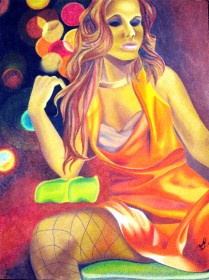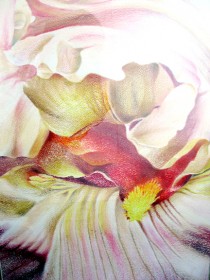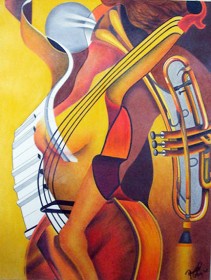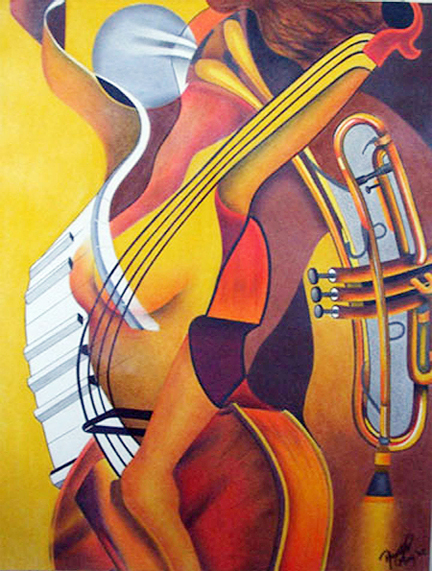By Kwesi Isles
Dominique Maria Hunter feels she stumbled into art in high school because she was not interested in anything else. But the 22-year-old executive member of the Guyana Women’s Artist Association is undoubtedly where she is meant to be. This week she speaks to The Scene about her work and her upcoming solo exhibition.

TS: How did you get into art?
DH: After I wrote art for CXC my art teacher at the time, Michael Welch, he was a board member at the Burrowes School of Art and he recommended that. I told him I wanted to pursue art and was thinking to go to the university but he said no, before you go to university you should enroll at Burrowes. So I started in 2004 at Burrowes and I did the three-year diploma programme. I graduated in 2007 as the Best Graduating Student.
TS: What medium do you work in?
DH: At the time I graduated with a major in Painting and a minor in Graphics but my focus has been mainly on drawing, I haven’t painted much.
TS: How much it would cost to pursue art studies?
DH: Art is very expensive that’s what a lot of people don’t realise, it’s very expensive to study art. My parents, oh my God, the amount of money… Frames are five to six thousand dollars a pop. We had requirements in order to graduate. [For] your major you had to produce about 20 to 25 pieces. Imagine that by $5,000 and that was just for that. When you got to Burrowes the first year they give you a long list of things you have to get because you have to do every subject area before you choose your minor and major. It was very expensive, if I didn’t have my parents I don’t know what would’ve happened. Burrowes was hard. A lot of people dropped out and not just because of the finance. But I guess I was one of the lucky ones because I didn’t have some of the challenges the others had. My parents were very supportive.

TS: What is art to you?
DH: There was a huge transformation and I’m still kind of surprised because … sometimes I feel like I stumbled onto art because in high school I wasn’t interested in business, I sure as hell wasn’t interested in science so all that was left was art. While I was at Bishops’ we didn’t have an art teacher for a long time until the end of third form and there really wasn’t much he could have done to prepare us for CXC, he tried his best but we missed out a lot of time. Looking back at the pieces I did back then I was not good, but I guess I liked the idea of being an artist. I have a cousin, he’s fantastic, he’s in New Jersey and he’s an extremely talented artist. When I was small I would look at his work and go wow, how could he do that. It went from not really interested to Burrowes. I think the passion really started a few months before I left Burrowes. One of my tutors was encouraging us to draw not just still life or landscape but to explore surrealism and that’s what basically set it off for me.
TS: What are your thoughts on the art being produced locally today?
DH: There are a lot of things that are definitely not the way they should be, there are a lot of things that need to be fixed. I did a lot of research on art and the pre-independence times and you realise that these people had very limited resources but the amount of work they were able to produce. They really put Guyana on the map and looking at it now it’s almost like we have regressed. We have so much now and we cannot do half the things they did.

TS: How did the surrealist influence begin?
DH: We did a lot of figure drawing and landscape and the tutor said she wanted us to think outside the box so she brought these books from the library and I was so fascinated by it and that was really the turning point for me. I haven’t explored surrealism in terms of painting. For me it’s like a wave I’m riding and I have to let it subside before I go on to anything else. My work is focused on drawing and I have studied a lot on surrealism, I’ve studied [Salvador] Dali, [Hieronymus] Bosch, I’ve studied a lot of modern surrealists Karl Pearson, Laurie Lipton, Jon Beinart so there’s definitely a major connection in my work. I think even if I go on to explore some other form of art somewhere lurking in the background surrealism is definitely going to be there.
TS: And here’s that most clichéd question. What is the source of your inspiration?
DH: Surrealism is really about tapping into the subconscious mind, dreams and it works for me because I’ve always had these ideas and what I like to do is juxtapose very strange and unusual elements. I guess when I was introduced to surrealism it just made sense. Sometimes I get these weird dreams and I would translate them, not entirely, and that’s how I work. I collect a lot of pictures every time I go online and I might use a piece from this picture, another piece from that picture and I mix them up and create something. Or sometimes you’re on the road and you see something, I don’t see it like other people. They might see a dog and say it’s just a dog. I might see something different and I think that comes from training. That’s why if anyone says they want to do art but don’t know where to go I would definitely send them to Burrowes. It’s important to have that formal training.

TS: I notice there is little that highlights your work as Guyanese. Is that deliberate?
DH: It’s kind of strange for me because I really don’t feel any connection like that and some people might be taken aback by that. I guess you can’t force what’s not there; I don’t feel any genuine connection or desire to portray anything Guyanese. If it comes out then it does. A lot of my stuff I rely on dreams and ideas I have, they aren’t particularly Guyanese oriented.
TS: Has technology influenced your work?
DH: It has. I learnt to use Photoshop when I started working and that was a whole other medium and the fact that you could cut out and fade and do all these great things on the computer and I said I want to bring this to my work so it does count out in my art. To get into Burrowes we had to draw two compositions and the first thing I was told was that “you have a very graphic technique.” My pencil strokes were very hard and that was something I had to learn so the transformation has been tremendous because before I could never soften my technique, the paper would almost be tearing and I had to learn to break away from that.
TS: What are some of the challenges facing artists locally?
DH: We have a lot. Going back you see it’s very unfortunate. I feel like Guyana has really dropped off the map in terms of visual arts. If you look at where we were, we were among the leading people in the arts. It’s like a cycle because some parents when they realise that their children aren’t gifted intellectually they send them to learn art or a trade. It’s difficult on the teachers then because you have to know English, you have to do Art Appreciation, Art History, Anatomy and stuff like that so it’s a challenge for them to work. So what happens, when they graduate they are not as good as they could have been and they are looking for work but can’t find any because they don’t have the necessary requirements. Well now in the art school I see they are doing actual computer graphics and that’s great because employers are looking for what you know on the computer. There aren’t many jobs out there for artists. I’m lucky that I went to Bishops so I know what I’m about. A lot of my friends from art school are still looking for work. So there’s a lot more to be done investment-wise.
It’s a shame that a lot of Guyanese have this perception of artists as being stupid and broke; this whole idea of the starving artist. Art started and was rooted in philosophy. If you go way back artists were the most respected in their societies and the highest paid and it’s a shame that people have it in their heads that art won’t take you anywhere. I’ve been told art is a hobby. I’ve been told I’m wasting my life and why I don’t go get an office job. It’s sad.
TS: Tell me about the exhibition you’re planning.
DH: The exhibition is something I’ve wanted to do for several years now. It will be my first solo exhibition. I exhibited before with the Guyana Women Artists Association and I was invited to Castellani House when they had an exhibition in February. The first time I exhibited was at the last Carifesta. When I approached Ms (Elfreida) Bissember to exhibit at Castellani House she was very excited when she saw my work. I told her it would be strictly drawings. Drawing is something that has been really underappreciated in Guyana. It’s the most valuable art form because you need a good drawing to make a good sculpture, for a good painting, and for a good house you need a good plan too. I felt like it was underappreciated especially pencil drawings so I thought I’m going to do the show about drawings and not just drawings but surreal-type drawings. (Dominique’s exhibition is scheduled for November 2010 at the National Art Gallery, Castellani House.) (kwesi_isles@yahoo.com)

